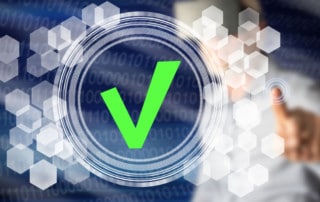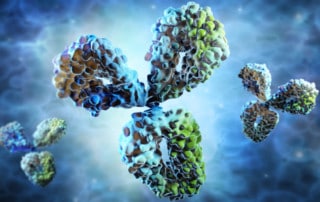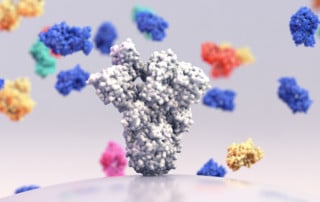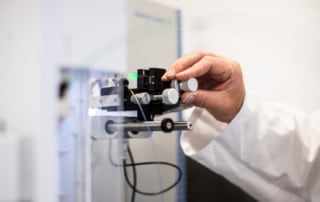Antibody Learning Centre.
Here you will find fundamental concepts and the general state of the art in our industry. Topics range from antibodies, to drug discovery and development, to protein characterization, to bioinformatics, and much, more.
- What is Protein Mass Spectrometry? – Article
- How to Determine Peptide Sequences – Article
- Antibody Characterization by Mass Spectrometry – Webinar
We encourage you to dive into more of our resources below. Contact us for more information.
Live Webinar
November 18, 2025 | 10:00AM EST
From Plasma to Protection: Sequencing Inhibitory Antibodies Against Malaria
Fill out the form to register
Latest Posts
Resources
What is Protein Mass Spectrometry?
Protein mass spectrometry refers to the use of mass spectrometry in studying and characterizing proteins, including their quantification, profiling, interaction mapping, and identification of their post-translational modifications. Protein mass spectrometry may also be referred to as mass spectrometry-based proteomics. Mass spectrometry-based proteomics comprises three approaches: top-down, middle-down, and bottom-up proteomics.
Key Pain Points in Amino Acid Sequencing & How to Avoid Them
Amino acid sequencing is commonly performed using Edman degradation or mass spectrometry (MS). While mass spectrometry is favoured for its high throughput capabilities and ease of use, both techniques possess their own features and limitations. This article summarizes some of the key pain points inherent in the two methodologies when determining the amino acid sequence.
What is the De Novo Amino Acid Sequencing Method?
Proteins are composed of peptide chains, which in turn are made up of a string or linear sequence of amino acids. Every amino acid has a basic structure containing an amino (-NH2) group and a carboxylic (-COOH) group (Figure 1B). To form a peptide, amino acids link to each other via a peptide bond, which involves the reaction between the carboxylic group of one amino acid and the amine group of another amino acid.
Why Verifying the Protein Sequence Is Crucial for Antibody Validation
As proteins are assembled, they fold into different structural orders: from primary to quaternary. The exact sequence of the primary structure (the amino acid sequence) will dictate how a protein will fold and function. The importance of the primary structure has been noted in several studies, where changes in the original amino acid sequence have resulted in affinity problems, binding disruption, reduced half-life, and higher aggregation odds.
De Novo Protein Sequencing vs DNA Sequencing
DNA sequencing is the process of determining the precise order of four nucleotides bases—adenine (A), guanine (G), cytosine (C), and thymine (T)—that make up the DNA molecule. From Sanger sequencing to next-generation sequencing (NGS), DNA sequencing’s accessibility and ease of use make it one of the most widely used technologies in life sciences.
Antibody Validation and its Use Cases
Antibodies are used in a variety of ways in academia and industry, from tools to therapeutics. Because antibodies are produced using live processes, which are naturally error-prone, validation is required from time to time. Furthermore, to develop biological therapeutics, the protein sequence must be confirmed as part of the regulatory process.
How to Determine Peptide Sequences
Amino acids (aa)—the building blocks of proteins—are simple molecules characterized by a variable R group flanked either side by an amino group and a carboxyl group. With around 20 different commonly found amino acids, each one can bond with another to produce chains that can be classified as peptides (typically below 50 aa) and proteins (sequences above 50 aa)—molecules ubiquitous to every known organism.
What are Monoclonal Antibodies?
Monoclonal antibodies (mAbs) are homogenous antibodies that bind to a single epitope on an antigen. Kohler and Milstein generated the first mAbs when they developed hybridoma technology in the 1970s. Because of the specificity, homogeneity and unlimited availability, mAbs are valuable reagents used in a variety of important applications including treatment and diagnosis of diseases
Why is Protein Sequencing Useful?
Protein sequencing is a method that typically utilizes mass spectrometry (MS) to determine the amino acid code of a protein1. Prior to the development of mass spectrometry, Edman degradation, a method involving the stepwise degradation of peptides to derive the order of amino acids, was the mainstream approach. Nowadays, mass spectrometry is favored due to its ease of use and high throughput capabilities, though Edman degradation is still employed for specific applications in which the technique is well suited.
Monoclonal vs Polyclonal Antibody Drugs
The transition from polyclonal antibody drugs to a more targeted monoclonal approach was made possible through a series of scientific and technological advancements; the most notable of which is the hybridoma technique developed by Köhler and Milstein, which allowed the generation of pure antibodies at scale.
Structure of an Amino Acid
Amino acids are small organic molecules that make up peptides and proteins. All living organisms share the same set of amino acids. Amino acids come together in different orders (sequences) to form proteins. As such, each type of protein has a different three-dimensional structure and biological activity.
How Do You Obtain the Sequence of an Antibody?
Antibody sequences are critical for antibody engineering and protein characterization in therapeutic development. For antibody reagent users, knowing the sequences allows them to perform sequence analysis/alignment to identify binding and cross-reactivity so they can conduct rational experiment design.
What is Protein Sequencing by Mass Spectrometry?
Nowadays, DNA sequencing is so popular that it is easy to forget that the first sequenced biological material was protein – insulin, by Sanger. Sanger, and another researcher, Edman, separately pioneered protein sequencing.
Antibody Protein Sequence Analysis Using Mass Spectrometry
One of the most important pieces of information researchers need to know during early stage antibody drug research and development is the sequence information of the antibody protein. With the advancement of mass spectrometry instrumentation and technologies, it is helpful, and sometimes critical, to conduct sequence analysis using mass spectrometry experiments.
Bispecific Therapeutics Explained
Bispecific therapeutics are monoclonal antibodies that carry a specific antigen-binding capability on each arm. Bispecifics are thus capable of having two specificities that can either double the binding affinity of the antibody toward the same antigen (increased avidity), or can now bind to two targets. Bispecifics are most often described as two types: trispecifics and bispecific T-cell engaged antibodies (BiTE).
Types of Antibodies
Written by: María Gerpe, PhD Updated: January 27, 2023 (Published: June 25, 2021) Contents Introduction Types of Antibody Structures Functions of [...]
Isoleucine and Leucine
Because they share the same mass, isoleucine and leucine are known as isobaric amino acids. Conventional mass spectrometry-based proteomics cannot be easily used to distinguish between isoleucine and leucine.
Major Antibody Databases and Their Applications
Written by María Gerpe, PhD June 18, 2021 Introduction Research publications represent an additional source of validation proof for commercially [...]
What is Amino Acid Sequencing?
Amino acid sequencing is the process of identifying the arrangement of amino acids in proteins and peptides. Numerous distinct amino acids have been discovered in nature but all proteins in the human body are comprised of just twenty different types.
Moving Towards Recombinant Monoclonal Antibodies
Recombinant Monoclonal Antibodies (rAbs) are highly reproducible, customizable and pure alternatives to the traditional antibodies produced by hybridomas. Get the antibody protein sequence, either by DNA sequencing or the de novo protein sequencing technology, you can rest assured that you can have the exact antibody made recombinantly anytime in the future.


























